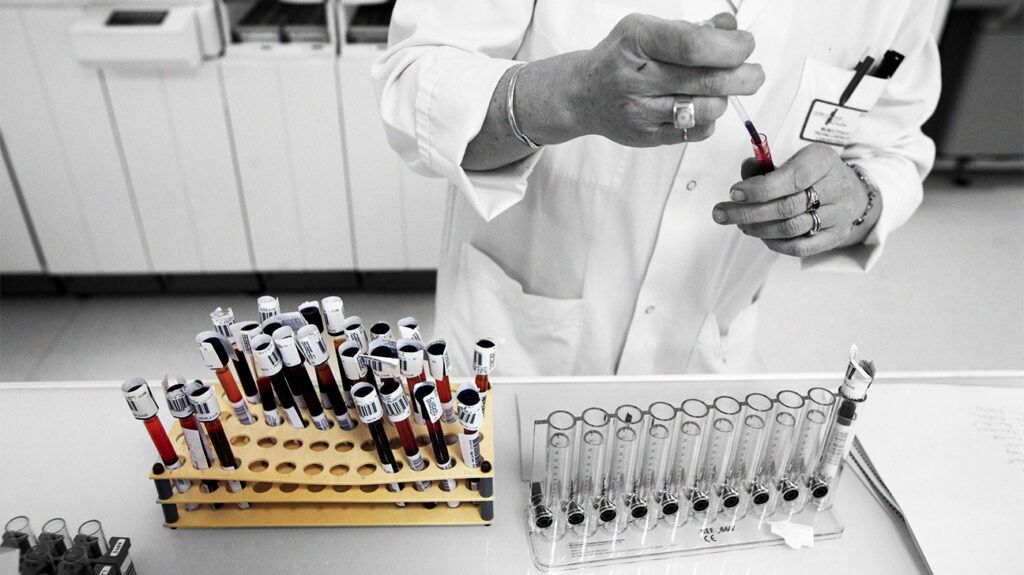Anemia of chronic disease (ACD) and iron deficiency anemia (IDA) are two conditions that share similar symptoms. However, they have different causes and may require different treatments.
ACD, also known as anemia of inflammation, and IDA are two forms of anemia. Anemia occurs when a person does not have enough red blood cells or hemoglobin, which is a protein in red blood cells that transports oxygen.
If a person has anemia, there may not be enough oxygen in their blood, which can cause them to feel weak or tired.
ACD occurs due to certain illnesses, whereas IDA occurs due to a lack of iron.
Read on to learn more about the differences between ACD and IDA, including their causes, symptoms, and treatments.

IDA
IDA occurs when a person does not have enough iron in their body. The
Possible causes of IDA include:
- bleeding in the gastrointestinal (GI) tract due to inflammatory bowel disease (IBD) or other GI disorders
- bleeding in the GI tract due to use of aspirin or other nonsteroidal anti-inflammatory drugs (NSAIDs)
- blood loss due to surgery or traumatic injury
- heavy menstrual periods
- bleeding during childbirth
- urinary tract bleeding
- certain rare genetic conditions that prevent the intestines from absorbing iron or make it harder to stop bleeding
- endurance sports
- intestinal or digestive conditions, such as celiac disease or ulcerative colitis
- surgery on the stomach or intestines, which may reduce the body’s ability to absorb iron
- kidney disease
- long-lasting conditions that cause inflammation, such as heart failure or obesity
ACD
ACD may occur due to certain chronic health conditions that cause inflammation. The
Conditions that may cause ACD include:
- chronic kidney disease
- autoimmune conditions, such as lupus or rheumatoid arthritis
- IBDs, such as Crohn’s disease or ulcerative colitis
- cancer
- chronic infections, such as tuberculosis and HIV
- other chronic diseases that cause inflammation, such as diabetes or heart failure
Experts believe that inflammation may change how a person’s immune system works. This may lead to the development of processes that cause ACD.
The National Organization for Rare Disorders states that the exact cause of ACD may depend on the condition that caused it. Chronic health conditions may cause ACD due to:
- low levels of erythropoietin (EPO), a hormone that the kidneys produce that stimulates red blood cell production
- low levels of the nutrients required to make red blood cells
- blood loss
- problems with cytokines, which are small proteins that
help cells communicate , such as:- cytokine secretion due to cancer or inflammation, which may suppress EPO
- cytokine secretion that reduces immature red blood cell response to EPO
- cytokine secretion that affects iron metabolism
- cancer cells or pathogens entering bone marrow, which produce red blood cells
- bone marrow not responding properly to EPO and making fewer red blood cells
- the body not storing or using iron correctly
- red blood cells having a shorter life, meaning they die before the body can replace them
Additionally, the NIDDK notes that a person may develop ACD due to inflammation resulting from aging.
ACD and IDA share similar symptoms, but there are some differences.
IDA
The
- tiredness
- dizziness or lightheadedness
- cold hands and feet
- pale skin
If a person has a more serious case of IDA, they may experience:
- tiredness
- shortness of breath
- chest pain
ACD
The
Possible symptoms of ACD include:
- tiredness or weakness
- rapid heartbeat
- shortness of breath
- body aches
- fainting
- lightheadedness
- becoming tired easily during or after physical activity
- paleness
The diagnostic process for both ACD and IDA involves similar steps, such as blood tests.
IDA
A doctor may ask a person about their symptoms when diagnosing IDA. They
- complete blood count
- blood iron levels
- levels of ferritin, which is a protein that stores iron in the body’s cells
ACD
The
A doctor may also take a sample of a person’s blood. They will send this sample to a laboratory, where a technician may check a person’s:
- red blood cell count and size of cells
- hemoglobin levels in the blood
- developing red blood cell count
- blood iron levels
- transferrin levels, which is a protein in the blood that carries iron
- ferritin levels
A doctor may diagnose a person with ACD if they have:
- anemia
- a low blood iron level
- a typical level of iron within their body’s tissues
There are different treatments for ACD and IDA.
IDA
The NHLBI notes that a doctor may treat a person with IDA in
- iron supplements
- intravenous (IV) iron
- erythropoiesis-stimulating agents (ESAs), which help the bone marrow produce more red blood cells
- blood transfusions for people with severe IDA
- surgery to repair internal bleeding if that is the cause of IDA
ACD
The NIDDK states that a doctor
Additionally, a doctor may prescribe a person certain medications to treat ACD. These may include ESAs or iron supplements.
A person may require a blood transfusion if they have severe ACD.
Anemia of chronic disease (ACD) and iron deficiency anemia (IDA) are forms of anemia. ACD occurs due to chronic health conditions, while IDA occurs due to iron deficiency.
The conditions can have similar symptoms, such as tiredness and lightheadedness. However, they have different underlying causes and may require different treatments.
If a person notices any signs of ACD or IDA, they need to speak with a doctor.
